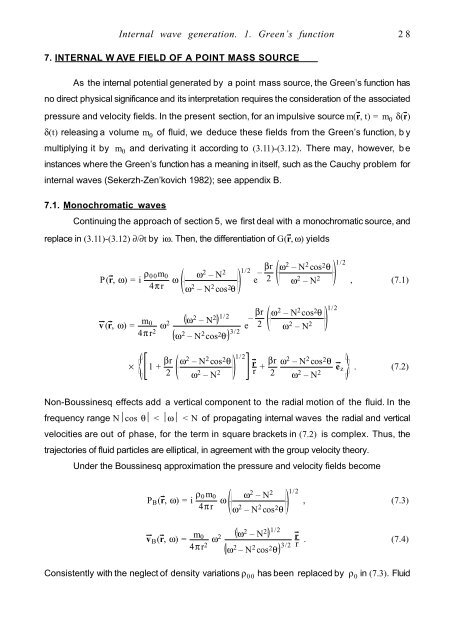Internal Wave Generation in Uniformly Stratified Fluids. 1 ... - LEGI
Internal Wave Generation in Uniformly Stratified Fluids. 1 ... - LEGI
Internal Wave Generation in Uniformly Stratified Fluids. 1 ... - LEGI
You also want an ePaper? Increase the reach of your titles
YUMPU automatically turns print PDFs into web optimized ePapers that Google loves.
7. INTERNAL W AVE FIELD OF A POINT MASS SOURCE<br />
As the <strong>in</strong>ternal potential generated by a po<strong>in</strong>t mass source, the Green’s function has<br />
no direct physical significance and its <strong>in</strong>terpretation requires the consideration of the associated<br />
pressure and velocity fields. In the present section, for an impulsive source m(r, t) = m 0 δ(r)<br />
δ(t) releas<strong>in</strong>g a volume m 0 of fluid, we deduce these fields from the Green’s function, by<br />
multiply<strong>in</strong>g it by m 0 and derivat<strong>in</strong>g it accord<strong>in</strong>g to (3.11)-(3.12). There may, however, be<br />
<strong>in</strong>stances where the Green’s function has a mean<strong>in</strong>g <strong>in</strong> itself, such as the Cauchy problem for<br />
<strong>in</strong>ternal waves (Sekerzh-Zen’kovich 1982); see appendix B.<br />
7.1. Monochromatic waves<br />
<strong>Internal</strong> wave generation. 1. Green’s function 28<br />
Cont<strong>in</strong>u<strong>in</strong>g the approach of section 5, we first deal with a monochromatic source, and<br />
replace <strong>in</strong> (3.11)-(3.12) ∂/∂t by iω. Then, the differentiation of G(r, ω) yields<br />
P(r, ω) = i ρ00m0<br />
4πr ω<br />
v (r, ω) = m0<br />
ω2<br />
4πr 2<br />
ω 2 – N 2<br />
ω 2 – N 2 cos 2 θ<br />
1/2<br />
ω2 – N2 1/2<br />
ω2 – N2cos2θ 3/2 βr<br />
–<br />
e<br />
× 1 + βr<br />
2 ω2 – N 2 cos 2 θ<br />
ω 2 – N 2<br />
1/2<br />
βr<br />
–<br />
e 2 ω2 – N2 cos2θ ω2 – N2 r r<br />
2 ω2 – N 2 cos 2 θ<br />
ω 2 – N 2<br />
1/2<br />
+ βr<br />
2 ω2 – N 2 cos 2 θ<br />
ω 2 – N 2<br />
1/2<br />
, (7.1)<br />
ez . (7.2)<br />
Non-Bouss<strong>in</strong>esq effects add a vertical component to the radial motion of the fluid. In the<br />
frequency range N⏐cos θ⏐ < ⏐ω⏐ < N of propagat<strong>in</strong>g <strong>in</strong>ternal waves the radial and vertical<br />
velocities are out of phase, for the term <strong>in</strong> square brackets <strong>in</strong> (7.2) is complex. Thus, the<br />
trajectories of fluid particles are elliptical, <strong>in</strong> agreement with the group velocity theory.<br />
Under the Bouss<strong>in</strong>esq approximation the pressure and velocity fields become<br />
PB(r, ω) = i ρ0 m0<br />
4πr ω<br />
vB(r, ω) = m0<br />
ω2<br />
4πr 2<br />
ω 2 – N 2<br />
ω 2 – N 2 cos 2 θ<br />
ω 2 – N 2 1/2<br />
1/2<br />
ω 2 – N 2 cos 2 θ 3/2 r r<br />
, (7.3)<br />
. (7.4)<br />
Consistently with the neglect of density variations ρ 00 has been replaced by ρ 0 <strong>in</strong> (7.3). Fluid


